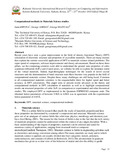Computational methods in Materials Science studies

View/
Date
2018-10-14Author
SIFUNA, James
AMOLO, George
MANYALI, George
Metadata
Show full item recordAbstract
Recent years have seen a great improvement in the field of density functional Theory (DFT)
calculation of electronic structure and properties of crystalline materials. There are many reasons
that explain the current successful application of DFT to materials science related problems: The
super speed of computers, software improvements and theory advancement. Based on these three
pillars, we the computing scientists were able to understand the ground state properties of cubic
scandium triflouride (ScF3) and if need arises, we willalso be able to explore the immense realm
of the virtual materials. Indeed, high-throughput techniques for the search of novel crystal
structures and the determination of band structure traits have become very popular in the field of
computational materials science. Despite these, many challenges are still being faced. Common
to all computational materials scientists is the unquenchable thirst for higher speed and better
accuracy in DFT calculations. This paper aims to present recent advances in the theory and
computational methods in DFT calculation of materials as well as to highlight computational
results on structural properties of cubic ScF3 in comparison to experimental and other theoretical
studies. We employed DFT as implemented in the Quantum ESPRESSO computer code. The
obtained lattice parameters of between 3.96Å to 4.06Å was in agreement with the experimental
lattice parameter of 4.03Å.
